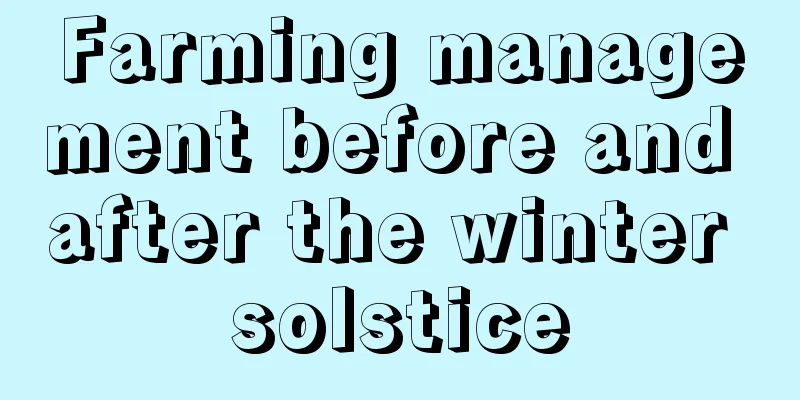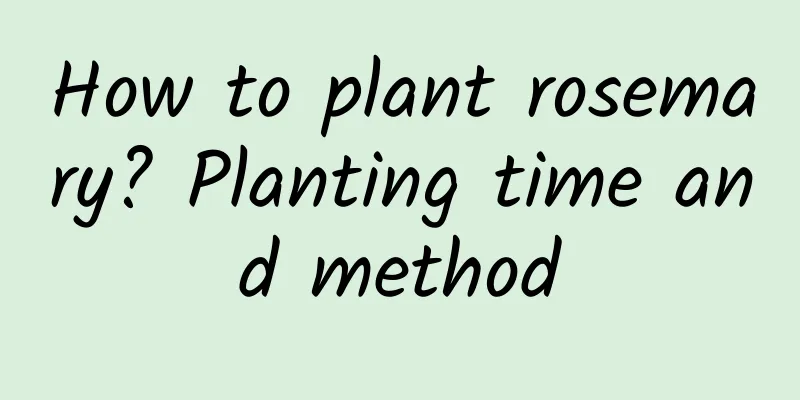Farming management before and after the winter solstice

|
During the winter solstice, the average temperature in most parts of northern my country is generally below 0℃, and the average temperature in most parts of southern China is around 6℃ to 8℃. Agricultural management at this time is also very important. Below, I will introduce agricultural management before and after the winter solstice. Let’s take a look. 1. Greenhouse vegetables Greenhouse vegetables should be inspected in a timely manner, and anti-cold and insulation measures should be taken as early as possible for weak insulation parts. Common insulation measures include covering with old straw thatch, thermal blankets and straw. For fruit and vegetable species that are in the fruit-bearing and harvesting period, in addition to keeping warm and preventing frost, attention should be paid to adjusting the environment such as light, temperature and humidity, and to watering and fertilizing scientifically to promote fruiting. The temperature in the greenhouse is low and the air humidity is high, which is conducive to the occurrence and spread of various vegetable diseases. Therefore, early prevention and control should be carried out according to the occurrence of the disease to ensure good growth of vegetables and stable production and yield. 2. Fruit trees When fruit trees enter a dormant period, the focus of management is shaping and pruning, garden cleaning, and frost prevention. The purpose is to build a high-yield framework, reduce overwintering pests and diseases, and prevent frost damage. Before frost damage occurs, appropriate anti-freeze measures for orchards include sufficient watering, crown covering, tree stump cultivation, trunk wrapping, trunk whitewashing, and fumigation to create clouds and increase warming. 3. Food crops At present, winter wheat in the north is in the wintering period, and most of the winter wheat in the south is in the three-leaf to tillering period. The temperature this year is close to the annual average or 1-3℃ higher than the annual average, which is generally conducive to the safe wintering and growth of winter wheat. Taking into account the differences in seedling conditions and soil environment, we should rationally strengthen water and fertilizer management to promote weak fields to become strong. For fields experiencing winter drought, we should irrigate the ditches with "running water" to protect the seedlings. Suppressing the cold wave according to local conditions before it arrives will help reduce frost damage, but it cannot be suppressed in a short period of time before the wave arrives to avoid damaging the wheat seedlings. 4. Cash crops Most of the rapeseed in the Yangtze River Basin has the fifth true leaf or above, and many have reached the 8-9 leaf stage. Some areas in central and western Jiangnan have entered the budding and bolting stage. Rapeseed can be fertilized with wax fertilizer according to the condition of the seedlings. In the past, wood ash was spread, which not only supplemented nutrition but also improved frost resistance. Now, rapeseed-specific fertilizer or urea (3-7 kg) and potassium fertilizer (3-6 kg) can be applied. Spray potassium dihydrogen phosphate, brassinolide, etc. around the winter solstice to enhance rapeseed's ability to resist cold and frost. For fields with vigorous growth or high density, paclobutrazol or chlorthiazolinone can be sprayed to reduce frost damage. For rapeseed that buds and shoots prematurely, the shoots should be removed and fertilizers applied in time to promote branch growth and avoid frost damage that leads to reduced yields. The above is an introduction to agricultural management before and after the Winter Solstice. Good farmland management should be done before and after the Winter Solstice, ditches should be cleared and drained in time, and the compacted winter soil that has not yet been plowed should be plowed as soon as possible to loosen the soil, enhance water storage and retention capacity, eliminate overwintering pests, and do a good job of cold protection for overwintering seedlings.
|
>>: What to do if orchid roots grow out of the soil, or only roots are left?
Recommend
Cultivation methods and precautions of creeping grass
Family farming methods soil Although creeping gra...
My wife said: If you buy more succulents, I will divorce you...
My wife said if I buy meat again, she will punish...
Planting methods and disease control of purple-leafed Berberis
Planting of Berberis rubrum Purple-leafed barberr...
When is the best time to prune peach blossoms? Can peach blossoms be pruned again?
1. Pruning time Peach blossom pruning is divided ...
Lychee Growing Conditions and Characteristics
Litchi Growth Conditions Lychees are generally mo...
If you grow flowers, grow money-attracting flowers. The pot will be full of money and your fortune will be unstoppable!
Money Tree The money tree, as the name suggests, ...
How to care for the newly bought fragrant vine (what kind of pot is suitable for growing fragrant vine)
How to care for the newly bought fragrant vine Th...
Fungus cultivation cost and profit
Wood ear is not only an edible fungus, but also a...
What fertilizer should be applied to passion fruit to produce more fruits?
1. What fertilizer to apply If you want passion f...
Can snail shells be used as fertilizer?
Snail shells as fertilizer Snail shells can be us...
How to grow money grass in winter, what are the precautions
1. Breeding methods 1. Increase light: Moneywort ...
What do 11 roses represent?
1. What does it represent? 1. Wholehearted: This ...
How to plant potted carnation seeds (what season to plant, is it easy to germinate)
1. Planting Season Carnations should be sown in s...
Can fig tree branches survive by grafting?
1. Can it be inserted alive? Fig branches can be ...
How to hydroponically cultivate pink palm
Select pot Choose a flowerpot according to the si...









